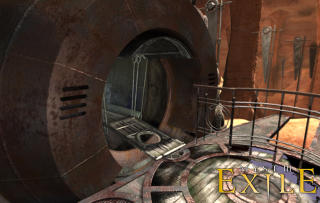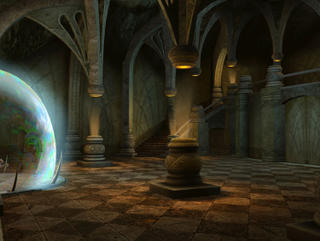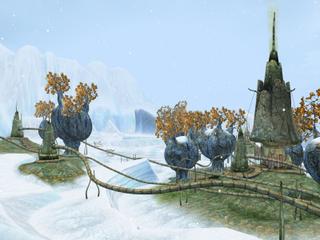- In a word: no. Just... just no. Can we pretend this game never happened? Can we? Please?
- The plot in a nutshell: Atrus' daughter Yeesha, previously seen as a bouncing, apple-cheeked cherub in Myst III: Exile, and more recently as a hilariously wooden young actress in Myst IV: Revelations, is all grown up, and has the facial tattoos and pretentious inner turmoil to prove it. She's also bugshit crazy but, surprisingly enough, not a homicidal maniac, which puts her ahead of the curve when it comes to her family. Yeesha and another D'ni survivor, Esher, send you on a dimly understood quest through the remains of the D'ni city and four other ages to collect four artifacts (the Slates) which will in turn release a fifth one--the fabulously powerful Tablet (not that we ever see even a hint of its power). The whole thing is very vague, and there are also some kind of alien creatures who respond to the Slates and the Tablet. In the end, you have to decide what to do with the Tablet, in an ending that mirrors the final choice of the original Myst, if by 'mirrors' we mean 'replicates the situation without any of the attendant tension or interest'.
- There's something profoundly un-Myst-ish about the entire game. It's not just the absurd and quest-like plot, but the very look of it. Myst games have always placed a high premium on beauty and on spectacle--lots of elaborate, lushly decorated interiors and breathtaking exteriors, lots of cut scenes, usually fly-bys, whose only reason to exist was to give the player a visual treat--see the following examples from Myst, Riven, Exile and Revelations:



 The price for all this exquisite detail was restriction of movement--the first two games were essentially slideshows, series of static tableaus, and although the third and fourth games allowed 360 degrees of motion from any fixed position, movement between these 'nodes' was still static.
The price for all this exquisite detail was restriction of movement--the first two games were essentially slideshows, series of static tableaus, and although the third and fourth games allowed 360 degrees of motion from any fixed position, movement between these 'nodes' was still static.
In End of Ages, the game designers made the decision to move to a fully immersive 3D environment--all movement is animated, at the cost of image definition and the aforementioned cut scenes (even the swirly fly-bys when you link into a new age are gone). You can see the results here:


 Pretty as they are, there's simply no comparison between these images and the earlier ones, and these screenshots fail to convey the gameplaying experience itself, which often seems to be a miserable cross between your average, polygonized FPS and Monkey Island. There's almost no detail and very little texture to the game worlds--they all come off rather plastic.
Pretty as they are, there's simply no comparison between these images and the earlier ones, and these screenshots fail to convey the gameplaying experience itself, which often seems to be a miserable cross between your average, polygonized FPS and Monkey Island. There's almost no detail and very little texture to the game worlds--they all come off rather plastic.
- And speaking of the plastic and the textureless, how about the decision to switch from live actors before a green screen to motion capture? I was rather critical of the game characters' appearance when I reviewed the Myst V demo, and I have to admit that there was some improvement on this front in the game itself. The characters' faces no longer look as if the skin were hung on a frame, and Cyan's 'face mapping' technique does allow an impressive range of expression. The final result is still plastic--there's simply no way to convey the intricacies of skin tone and muscle movement with motion capture alone--but it suits the look of the game itself. To bring live actors into this paltry environment would only call attention to its deficiencies.
- The decision to move away from highly detailed graphics falls flat on its face when it comes to the game's non-human characters. Previous Myst games, Exile and Revelations in particular, incorporated lovely and realistic animal characters capable of tugging at the player's heartstrings. When End of Ages introduces the Bahro, the alien creatures whose fate is inextricably bound with the Tablet, what we get looks like something we'd be expected to shoot at, a rough conglomeration of mud-colored polygons. With watermelon-shaped lumps studded with eyes for faces, the Bahro have zero range of expression, which hardly contributes to a sense of sympathy for their plight.
- Credit where credit's due: the voice acting for Yeesha and Esher is really quite good, a first for the series (even Brad Dourif couldn't do much with his role in Exile). The motion capture acting is slightly less engaging, mostly because of the plasticity of the characters but also because, possibly as a way of compensating for their limited facial movements, the actors chose to convey emotion with lots of exaggerated hand waves and body movements.
- Another point in the game's favor: for the first time in the series, the writers have not only acknowledged but embraced the inherent bleakness of its premise. After all, we're talking about a group of people who are the last survivors of a fallen empire. Great-grandma was indirectly responsible for this fall, grandpa was a despotic maniac, Mom's a depressive, and the two sons are psychopaths. The notion that Atrus or Yeesha might be even remotely normal--which we had been expected to swallow in previous games--is here exposed as an absurdity. The game opens with what appears to be Atrus' suicide note, and culminates with a visit to Myst, to which the intervening years have not been kind. The writers have to have been aware of the effect that seeing the island as it is now--a water-logged, overgrown waste, its structures ruined by time and neglect--would have on long-time fans of the series, and they revel in it. These two scenes suggest a darkness that the rest of game shies away from, to its own detriment.
- Since I raised the issue when I first wrote about the Myst series, I suppose I have to deal with the question of anti-intellectualism in the game--does Myst V continue the series' trend of vilifying intellect and extolling 'wisdom'? To a certain extent, yes--Esher, the villain of the piece, is obsessed with D'ni's lost stores of knowledge, and lambasts Yeesha's vague spirituality. But like the rest of the game's story, this juxtaposition is so vague as to barely register with the player, and so Myst V turns out to be less virulently anti-intellectual than Revelations or Exile.
- You'll note I haven't said a word about the puzzles. In all honesty, I needed hints on more than one occasion, but I don't say this to praise the game's difficulty. The original Myst's puzzles grew organically out of the game world--they were genuinely about figuring out how the world you were in worked--but after Riven, the series started moving away from these organic puzzle. Unfortunately, the games never fully made the transition to the 'look, there's a chess problem under this carpet' type of puzzle, and the result strains the player's suspension of disbelief even as it demands it. For example, one of Myst V's early puzzles involves getting out of an icy cavern. The solution is to place the Slate on a particular spot, where, helpfully enough, the outline of a slate has been drawn. Even if we could ignore the fact that this use of the Slate is completely inconsistent with everything we've come to learn about it, or that there's no reason why placing it in that position should crack the ice, there remains one inescapable question--who drew that outline, and why? That the game designers can introduce such an absurdity with a straight face and then turn around and explain that really, this combination of pulled levers will allow you to cross over to that location because there's a lifeform in the water that responds to heat blah blah blah simply serves to confuse the player--how much realism should we expect from the game? The answer is constantly shifting, and makes for a frustrating gameplaying experience.
- A word of advice to Cyan's marketing people: you do realize that the universal reaction to your chosen tagline, "Choose Wisely, For There Will Be No Second Chance", is "Is there something wrong with the save function?"
- I can't imagine any hardcore Myst fan will be swayed by this recommendation, but I'll make it anyway: don't buy this game. It isn't a worthy successor to the Myst title, not even the two most recent sequels. It does wrap up the Myst universe, but in a way that will actually make you glad that there will be no further games, and I know that's not how any rabid fan wants to feel about a beloved series.
To subscribe to posts on Asking the Wrong Questions, use the RSS feed, or sign up for email notifications at follow.it



 The price for all this exquisite detail was restriction of movement--the first two games were essentially slideshows, series of static tableaus, and although the third and fourth games allowed 360 degrees of motion from any fixed position, movement between these 'nodes' was still static.
The price for all this exquisite detail was restriction of movement--the first two games were essentially slideshows, series of static tableaus, and although the third and fourth games allowed 360 degrees of motion from any fixed position, movement between these 'nodes' was still static.

 Pretty as they are, there's simply no comparison between these images and the earlier ones, and these screenshots fail to convey the gameplaying experience itself, which often seems to be a miserable cross between your average, polygonized FPS and Monkey Island. There's almost no detail and very little texture to the game worlds--they all come off rather plastic.
Pretty as they are, there's simply no comparison between these images and the earlier ones, and these screenshots fail to convey the gameplaying experience itself, which often seems to be a miserable cross between your average, polygonized FPS and Monkey Island. There's almost no detail and very little texture to the game worlds--they all come off rather plastic.
Comments
Post a Comment